
The Lacertidae are the family of the wall lizards, true lizards, or sometimes simply lacertas, which are native to Europe, Africa, and Asia. The group includes the genus Lacerta, which contains some of the most commonly seen lizard species in Europe. It is a diverse family with at least 300 species in 39 genera.

Adolfus is a genus of lizards of the family Lacertidae. The genus is endemic to subsaharan Africa.
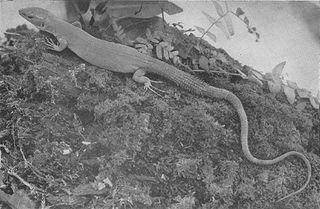
Gastropholis is a genus of Equatorial African lacertid lizards of the family Lacertidae which is distributed in southern Liberia, Ivory Coast and Ghana, western Cameroon, Equatorial Guinea, Democratic Republic of Congo, eastern Kenya, Tanzania and south to northeastern Mozambique.

Holaspis is a genus of equatorial African lizards in the family Lacertidae. These lizards are capable of gliding flight for distances of 30 meters.

Latastia is a genus of lizards of the family Lacertidae. Species of this genus are distributed in Africa but one subspecies lives in Yemen. Collectively, they are known as long-tailed lizards.

Philochortus is a genus of lizards of the family Lacertidae. Species of this genus are distributed in Egypt, Algeria, Libya, Mali, Niger, Ethiopia, Djibouti, Eritrea, Somalia, Kenya, Yemen, and Saudi Arabia.
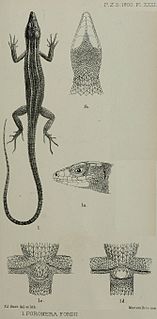
Poromera is a genus of lizard in the family Lacertidae. The genus Poromera is monotypic, containing the single species, Poromera fordii, commonly known as the West African striped lizard. The species is endemic to western Central Africa.

Pseuderemias is a genus of lizards of the family Lacertidae. Common names for the genus are false sand lizards or racerunners.

Banyamulenge are the Tutsi tribe that arrived in Congo in the 19th century from Rwanda. Banyamulenge is a term historically referring to mountains concentrated on the High Plateau of South Kivu, in the eastern region of the Democratic Republic of the Congo, close to the Burundi-Congo-Rwanda border.

The Albertine Rift is the western branch of the East African Rift, covering parts of Uganda, the Democratic Republic of the Congo (DRC), Rwanda, Burundi and Tanzania. It extends from the northern end of Lake Albert to the southern end of Lake Tanganyika. The geographical term includes the valley and the surrounding mountains.
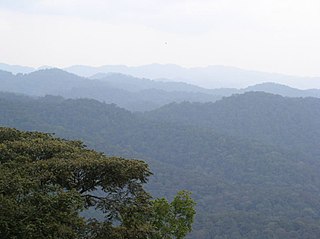
The Albertine Rift montane forests is a tropical moist broadleaf forest ecoregion in east-central Africa. The ecoregion covers the mountains of the northern Albertine Rift, and is home to distinct Afromontane forests with high biodiversity.
Leptopelis karissimbensis is a species of frog in the family Arthroleptidae. It is found in the highlands of western Rwanda and southwestern Uganda and in the adjacent eastern Democratic Republic of the Congo. It is very similar to Leptopelis kivuensis and has been confused with that species. Common names Karissimbi forest treefrog and Karissimbi tree frog have been coined for it.

Leptopelis kivuensis is a species of frog in the family Arthroleptidae. It is found in the highlands of western Burundi, Rwanda, and Uganda, and in the extreme eastern Democratic Republic of the Congo. It has been considered synonym of Leptopelis karissimbensis, and has been confused with that species. Common names Kisenyi forest treefrog and Kivu tree frog have been coined for it.
The Albertine owlet is a little known species of small owl in the family Strigidae which occurs in a small area of montane forest in east central Africa.
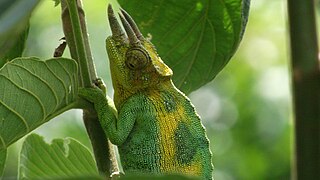
Trioceros johnstoni, known commonly as Johnston's chameleon, Johnston's three-horned chameleon, or the Ruwenzori three-horned chameleon, is an endemic chameleon of the Albertine Rift in Central Africa.
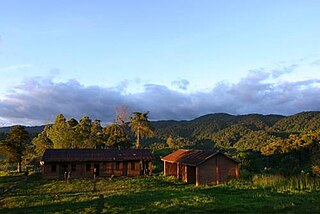
The Itombwe Mountains are a range of mountains in the South Kivu province of the Democratic Republic of the Congo (DRC). They run along the west shore of the northern part of Lake Tanganyika. They contain a vast area of contiguous montane forest and are home to a rich diversity of wildlife.

Charaxes imperialis, the imperial blue charaxes, is a butterfly in the family Nymphalidae. It is found in Guinea-Bissau, Guinea, Sierra Leone, Liberia, Ivory Coast, Ghana, Benin, Nigeria, Cameroon, Equatorial Guinea, the Republic of the Congo, the Central African Republic, the Democratic Republic of the Congo, Rwanda, Uganda, Tanzania and Zambia. The habitat consists of lowland to sub-montane forests.
Kinyongia itombwensis is species of chameleons endemic to the eastern Democratic Republic of the Congo. Its common name is Itombwe forest chameleon.

Adolfus jacksoni also known as Jackson's forest lizard, is a species of lizard found in Kenya, Uganda, Rwanda, Burundi, Tanzania, and the Democratic Republic of the Congo.

Congolacerta vauereselli also known as the sparse-scaled forest lizard, is a species of lizard found in Uganda, Tanzania, Rwanda, Burundi, and the Democratic Republic of the Congo.



















